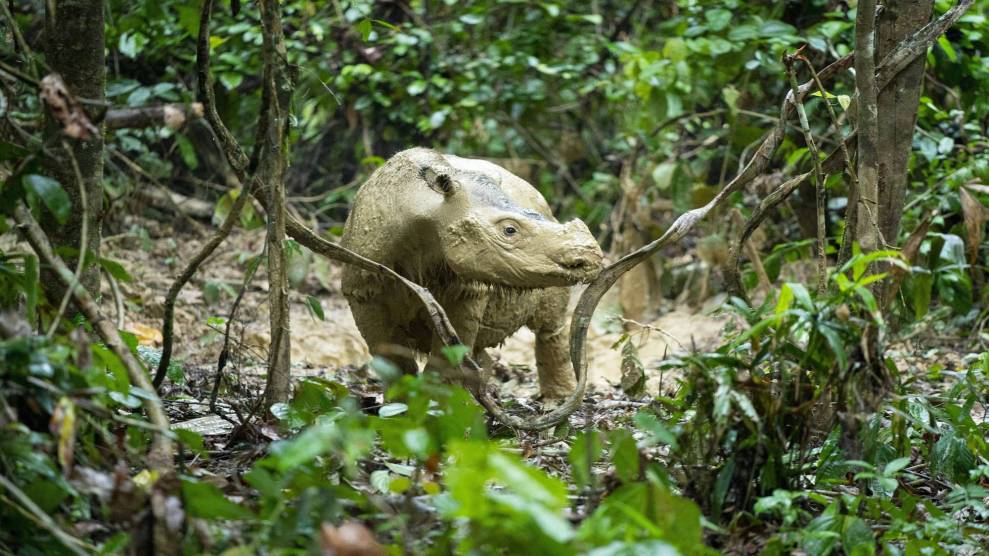
A slow loris.Roni Ornax/iStock/Getty
This story was originally published by the Guardian and is reproduced here as part of the Climate Desk collaboration.
From the ring-tailed lemur to the aye-aye, a nocturnal primate, more than 20 million years of unique evolutionary history could be wiped from the planet if nothing is done to stop Madagascar’s threatened mammals going extinct, according to a new study.
It would already take 3 million years to recover the diversity of mammal species driven to extinction since humans settled on the island 2,500 years ago. But much more is at risk in the coming decades: if threatened mammal species on Madagascar go extinct, life forms created by 23 million years of evolutionary history will be destroyed.
“Our results suggest that an extinction wave with deep evolutionary impact is imminent on Madagascar unless immediate conservation actions are taken,” researchers wrote in a paper published in Nature Communications. Madagascar is one of the planet’s biodiversity hotspots with 90 percent of its species found nowhere else on the planet, yet more than half of its mammal species are threatened with extinction.
So much is on the line because the island is relatively pristine and is home to wildlife that has evolved nowhere else, having split from greater India around 88 million years ago. It is the world’s fourth largest island, about the size of Ukraine, and much of its diversity has been built on species coming from Africa and then diversifying over millions of years.
“It’s about putting things in perspective—we’re losing unique species traits that will probably never evolve again,” said lead researcher Dr Luis Valente from the Naturalis Biodiversity Center in Leiden, the Netherlands, and the University of Groningen. “Every species is valuable in its own right; it’s like destroying a piece of art, so what is happening is very shocking.” His team collaborated with researchers from the US and the conservation organization Association Vahatra in Madagascar.
The island is particularly known for its ring-tailed lemurs, members of a unique lineage of primates found nowhere else. Other well-known inhabitants include the fossa, a carnivorous cat-like animal, and the panther chameleon, as well as a vast array of unique butterflies, orchids, baobabs, and many other species.
Biologists and palaeontologists created a dataset that showed all the mammal species currently present on the island, those that were alive when humans arrived, and those known only from fossil records. Of the 249 species identified, 30 are extinct. More than 120 of the 219 mammal species alive today on the island are threatened with extinction.
Lost species can never return, and so the study looked at how long it would take to recover the same levels of biodiversity through new species colonizing and evolving on the island.
Valente said: “Lots of these species could be going extinct in the next 10 or 20 years—they cannot wait much longer. You can quickly reach a point where a species isn’t viable any more. The main message is that biodiversity is not going to recover quickly. Even the places we think are pristine and really untouched can be pushed to the point of collapse quite quickly.”
The loss of mammals would have significant impacts on other species of plant and insect that depend on them. Valente said: “It’s a cascading effect—losing these mammals would likely cause a collapse of the ecosystem more broadly. In total, it is likely to be more than 23 million years at stake.”
The main threats are human-induced habitat destruction, climate change and hunting. During the past decade, the number of mammal species threatened with extinction on Madagascar has more than doubled, from 56 in 2010 to 128 in 2021. Conservation programmes are needed to create livelihoods for local people, to stop forests being converted into farmland, and to limit the exploitation of resources such as hardwood trees and animals used for bushmeat, the paper’s authors said.
Yadvinder Malhi, a professor of ecosystem science at the University of Oxford, who was not involved in the research, said: “This fascinating study shows it would take millions of years for natural processes to rebuild the levels of biodiversity already lost, and tens of millions of years if currently threatened species are also lost. While this study looked at Madagascar, similar analyses could be done for other islands and continents, and I think would tell a similar story.
He added: “The impact humanity has already had on Earth’s biodiversity will last for millions of years, but the next few decades are hugely important for avoiding large-scale extinction that could have much deeper and longer consequences.”












